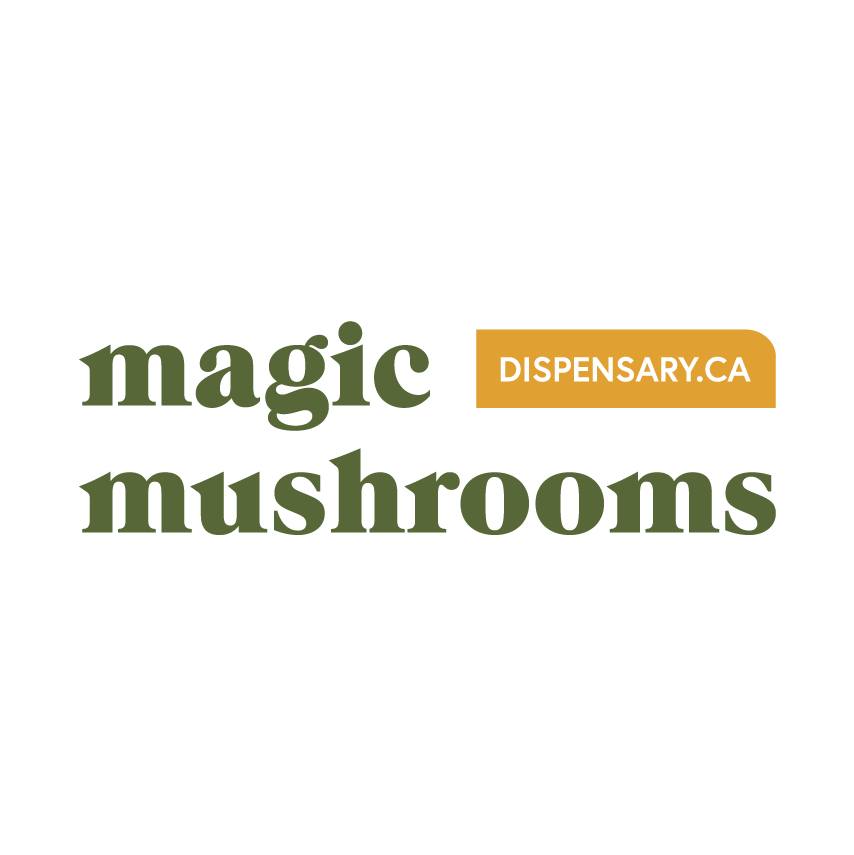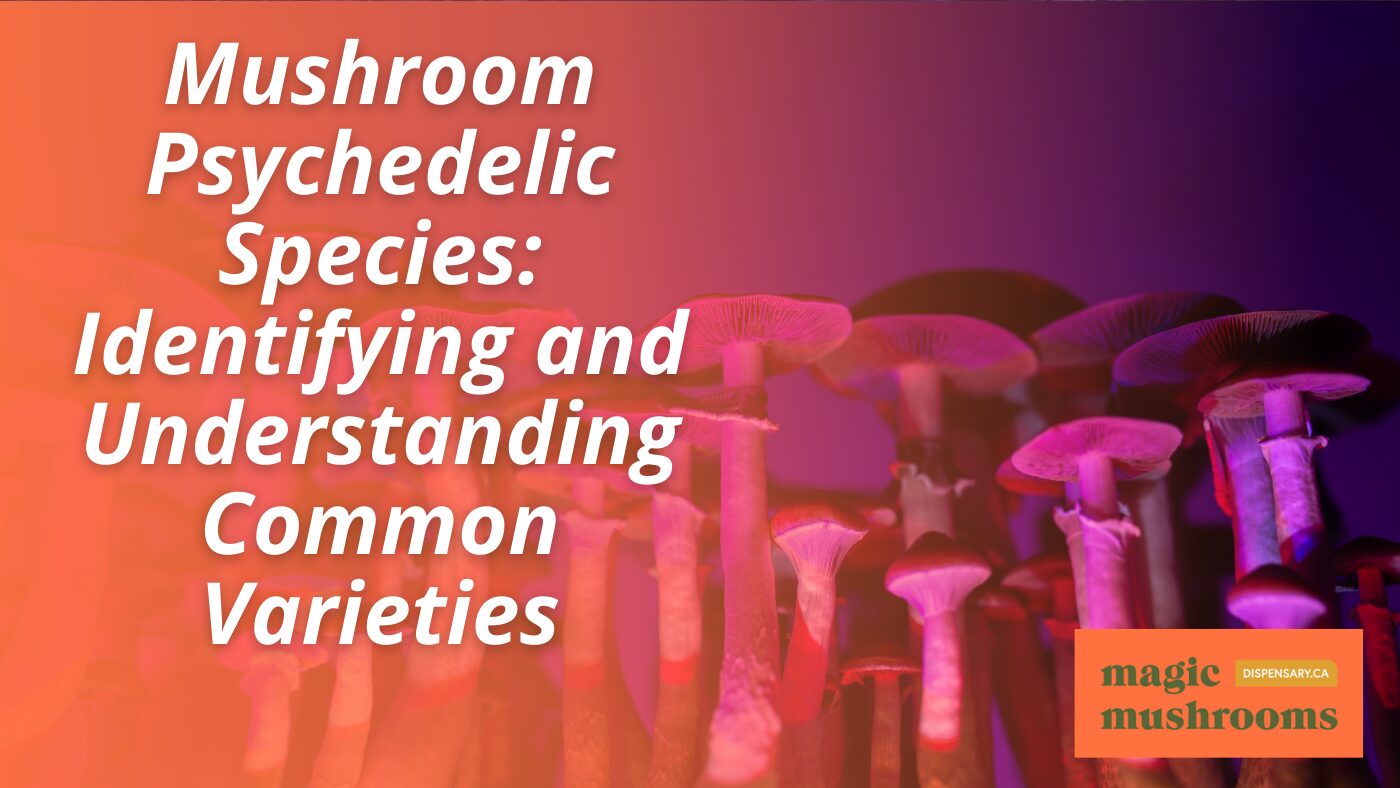Psychedelic mushrooms, including varieties from the Psilocybe, Panaeolus, and Gymnopilus species, are recognized for their distinctive features and the potent psilocybin and psilocin they contain. Among them, Psilocybe cubensis stands out for its golden-brown cap, while Psilocybe azurescens is notable for its undulating caps and powerful effects. Panaeolus cyanescens, also known as ‘Blue Meanies’, thrive in tropical climates and are packed with psychoactive substances. Each type of mushroom provides unique experiences and potential therapeutic benefits. Delving into the details of these psychedelic mushrooms can offer a deep understanding of their fascinating universe, shining a light on the special characteristics and importance of each species.
Key Takeaways
- Psilocybe cubensis, Psilocybe semilanceata, and Psilocybe azurescens are popular psychedelic mushroom species known for their high psilocybin and psilocin content.
- Gymnopilus purpuratus and Gymnopilus spectabilis are North American species, identifiable by their coloration and recognized for their psychoactive properties.
- Panaeolus cyanescens and Panaeolus sphinctrinus, found in warm climates and grassy areas respectively, are marked by their rich psilocybin content.
- Other psychedelic mushroom species include Inocybe, Mycena, and Copelandia genera, each with unique species displaying intense psychoactive effects.
- Psilocybe mexicana and Psilocybe zapotecorum, native to Mexico, are traditionally used in spiritual practices and are known for their potent hallucinogenic effects.
Understanding Mushroom Psychedelic Species
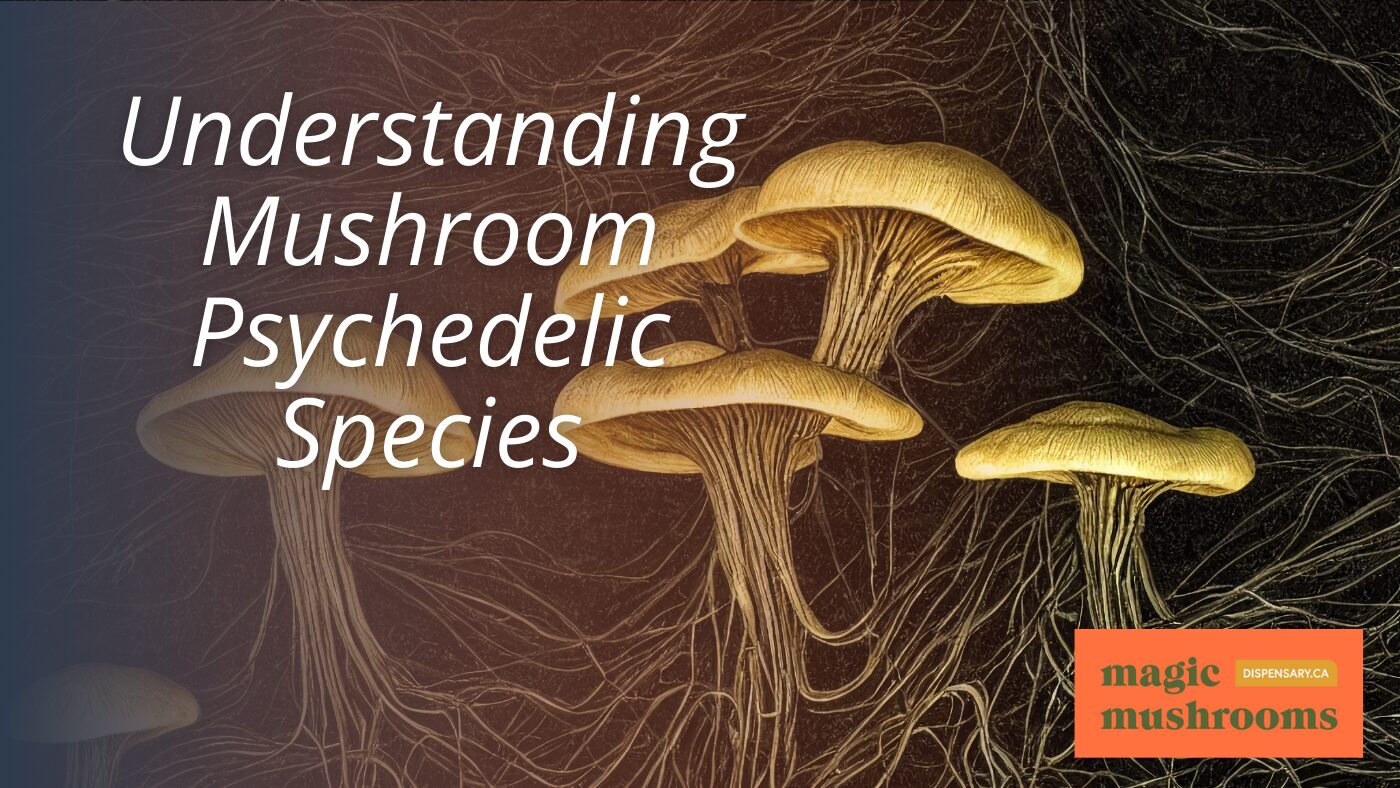
Delving into the understanding of psychedelic mushroom species, one must consider the diversity within Psilocybin, Gymnopilus, Panaeolus, Inocybe, and Mycena genera, all of which encompass a variety of unique and globally distributed species. These genera are not only pivotal in variety but also in the psychoactive compounds they contain, primarily psilocybin, a substance known for its potential therapeutic applications in mental health treatments.
Psilocybe species, for instance, are globally distributed and include Psilocybe aztecorum, Psilocybe makarorae, Psilocybe niveotropicalis, Psilocybe subcubensis, and Psilocybe weraroa. These species have evolved unique defense mechanisms, possibly to deter grazing animals, and are typically found in urban environments and the Pacific Northwest region.
Gymnopilus species, on the other hand, include Gymnopilus dunensis, Gymnopilus luteus, Gymnopilus purpuratus, Gymnopilus sapineus, and Gymnopilus viridans. Species of this genus are found in a variety of habitats, ranging from forests to grasslands.
Panaeolus species include Panaeolus africanus, Panaeolus bisporus, Panaeolus cambodginiensis, Panaeolus cinctulus, and Panaeolus cyanescens. These mushrooms typically grow on dung and are more prevalent in warmer climates.
Inocybe species include Inocybe aeruginascens, Inocybe corydalina var. corydalina, Inocybe tricolor, and other unidentified species. They are known for their fibrous stems and conical caps.
Lastly, Mycena species like Mycena cyanorrhiza and Mycena pura are small, delicate mushrooms often found in forested areas.
The understanding of these diverse species is an essential step towards liberation from ignorance, fostering a knowledge that could potentially revolutionize therapies in mental health.
Psilocybe Cubensis Identification
Among the myriad of psychedelic mushroom species, Psilocybe cubensis stands out as one of the most common and well-known due to its distinctive physical characteristics and potent levels of psychoactive compounds. This species, often referred to as ‘cubes’ by enthusiasts, has a unique aesthetic appeal with its large, golden-brown cap punctuated by a peculiar nipple-like structure.
The identification of Psilocybe cubensis is an essential skill for anyone interested in studying or exploring the world of psychedelic fungi. Their ability to thrive in tropical and predominantly regions, mostly in humid environments, adds to their widespread distribution. This characteristic makes them a frequent find in pastures and fields, especially those that have been enriched with bovine or equine manure, which provides the necessary nutrients for their growth.
Psilocybe cubensis is renowned for its potent concentrations of psychoactive substances, namely psilocybin and psilocin. These compounds are responsible for the intense psychedelic effects experienced by those who consume these mushrooms, contributing to their popularity for recreational and spiritual use.
Cultivation of Psilocybe cubensis has become rather common due to their accessibility and the robust psychedelic experiences they induce. However, it is important to note that cultivation and consumption laws vary widely worldwide, necessitating adequate knowledge and understanding of local regulations.
Psilocybe Semilanceata Characteristics
Turning our attention to Psilocybe semilanceata, commonly known as the ‘liberty cap,’ this species is a prevalent psychedelic mushroom found in grassy areas and fields. Its distinctive conical or bell-shaped cap, usually measuring between 0.5-2 cm in diameter, is one of the many attributes that makes it stand out.
Psilocybe semilanceata is not just known for its unique appearance, but also for the psychoactive compounds it contains—namely psilocybin and psilocin. When ingested, these compounds can lead to hallucinogenic effects, opening the doors of perception for those who seek a transcendental experience. However, these should be approached with caution, as they also have the potential to cause distressing experiences.
A key characteristic aiding in the identification of Psilocybe semilanceata is the color of its spores, which are dark purple-brown. This is a useful feature for those who are foraging and need to differentiate between various species of mushrooms.
In some regions, Psilocybe semilanceata is highly sought after. Its potency and widespread distribution make it an attractive option for those in pursuit of the liberty cap’s mind-altering properties. However, it is important to remember that while Psilocybe semilanceata offers the potential for deep introspection and mental exploration, it should be approached with respect and a deep understanding of its powerful effects.
The Unique Panaeolus Cyanescens
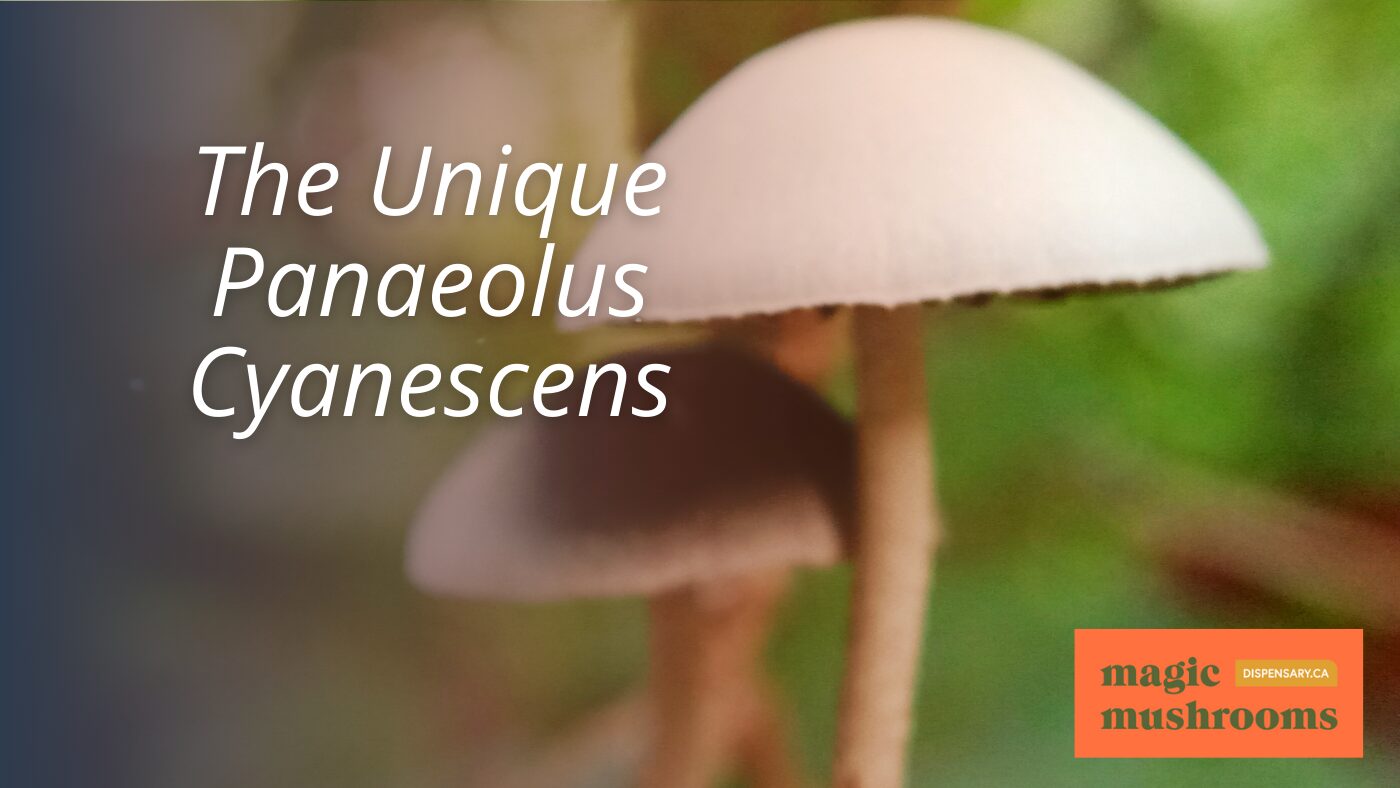
Moving forward, we shift our focus to the unique Panaeolus cyanescens, a potent psychedelic mushroom species also known as the ‘Blue Meanies’. This species, rich in the psychoactive compounds psilocybin and psilocin, is renowned for its potency. Small in size, it carries a dark purple-brown spore print and displays a distinct blue bruising reaction when handled, a characteristic trait of many psilocybin-containing species.
Panaeolus cyanescens thrives in warm, tropical climates, commonly found in grassy areas and fields. Its distribution is widespread, but it mainly graces the regions that provide it with the heat and humidity it prefers. This species is a demonstration of the adaptability and resilience of psychedelic mushrooms, as they continue to flourish across diverse ecological niches.
The ‘Blue Meanies’ are not just known for their environmental preferences and distinctive physical characteristics. The effects they induce are notably intense. Consumption often leads to visual distortions, euphoria, and an altered perception of time. These effects, while sought for their potential therapeutic applications, are powerful and can be overwhelming if not approached with caution.
Due to its high potency, users of Panaeolus cyanescens are always advised to start with small doses. This cautionary advice emphasizes the importance of understanding and respecting the power of these natural substances. As with any psychedelic species, responsible use is key to tapping into their potential benefits and minimizing risks. The ‘Blue Meanies’, with their unique characteristics and potent effects, are a fascinating addition to the diverse world of psychedelic mushrooms.
Psilocybe Azurescens Description
Shifting our gaze from the tropical ‘Blue Meanies’, we now encounter Psilocybe azurescens, a potent psychedelic mushroom species native to the Pacific Northwest region of the United States. This remarkable species stands out not only for its native habitat but also for its notable potency, featuring high levels of the psychoactive compounds psilocybin and psilocin.
Psilocybe azurescens is identifiable by its large, wavy caps that can reach up to 10 cm in diameter. Its distinctive morphology is further characterized by a conic to convex cap which becomes plane in age, often with an umbo, and the coloration varies from caramel to chestnut-brown, but fades to straw color in drying. The stipe is 90 to 200 mm in length, fibrous, and bluish or bluish-green where bruised.
The species is often found flourishing in coastal areas, particularly on decaying wood and wood chips, echoing its unique affinity for lignin-rich substrates. The prevalence of this species in these regions is a confirmation of its adaptability and resilience, and its presence contributes to the biodiversity and ecological balance of these areas.
Consumption of Psilocybe azurescens can induce intense psychedelic effects, including vivid hallucinations and drastically altered perceptions. These powerful effects have piqued the interest of researchers and enthusiasts alike, leading to a deeper exploration of the therapeutic potential of this fascinating species. As we continue to uncover the intricacies of this mushroom, it’s paramount to approach with respect, caution, and a desire for understanding.
Gymnopilus Purpuratus Features
In the domain of psychoactive fungi, Gymnopilus purpuratus holds a distinctive place, known for its unique purple coloration and hallucinogenic properties. This species belongs to the Gymnopilus genus, a diverse group of fungi that have captured the interest of mycologists, researchers, and foragers alike due to their psychoactive attributes. The vivid aesthetics of Gymnopilus purpuratus, coupled with its psychoactive properties, make it a species of significant interest.
Gymnopilus purpuratus primarily inhabits North American regions, flourishing in woodlands and forested areas. Its choice of habitat is a nod to its ecological role as a saprophyte, decomposing organic matter and contributing to the nutrient cycling process in these ecosystems. This aspect is particularly notable for those keen on foraging or studying these psychedelic mushrooms, as understanding the species’ ecological footprint is important to identifying its growth sites.
The most salient feature of Gymnopilus purpuratus, however, is its psychoactive properties. The mushroom contains compounds that induce hallucinogenic effects when ingested, a characteristic that has stirred intrigue and apprehension in equal measure. It is essential to underscore the importance of informed and responsible usage of such substances. The potential of these compounds for therapeutic use in mental health treatments is a burgeoning field of research, but it also underscores the need for careful, controlled exploration. Understanding Gymnopilus purpuratus, therefore, is not just about identifying its physical features, but also acknowledging its broader implications in the domains of ecology, human health, and societal norms.
Recognizing Psilocybe Cyanescens
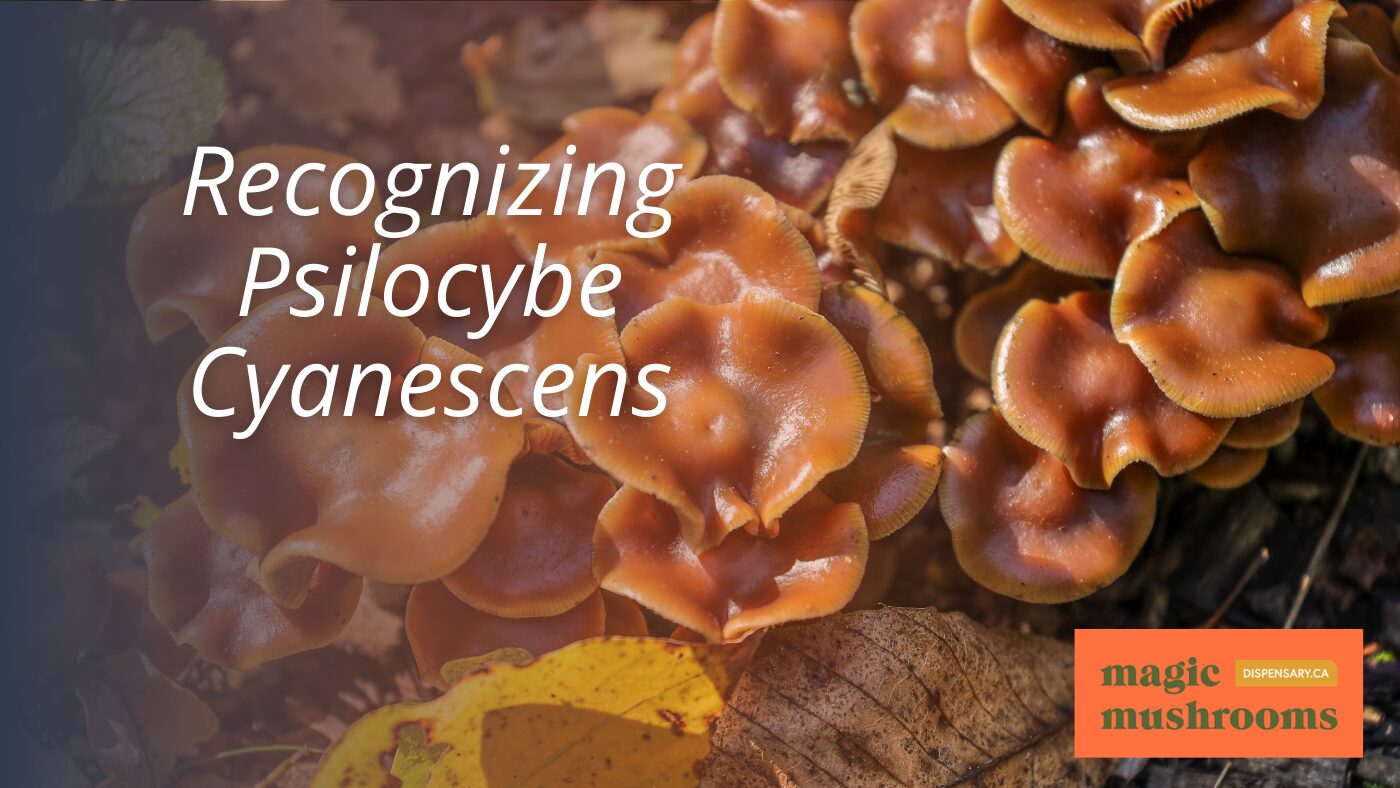
Turning our attention from Gymnopilus purpuratus, another species of interest within the domain of psychoactive fungi is Psilocybe cyanescens. This species, commonly found in the Pacific Northwest, is known for its affinity for woodchip-rich environments, often thriving in urban areas where such substrates are plentiful. This notable adaptability has resulted in a global distribution, with documented presences in the U.S., Europe, South Africa, New Zealand, and Australia.
The cyanescens species is well recognized for its potent content of the psychoactive compound psilocybin. This biochemical component is responsible for the hallucinogenic effects that have made these fungi a subject of interest among researchers, foragers, and those seeking cognitive liberation. The presence of psilocybin is typically evident through a unique physical attribute of the mushroom: when crushed or bruised, Psilocybe cyanescens exhibits a characteristic purplish-blue coloration, providing a valuable identification aid for those familiar with the species.
It is worth noting that while Psilocybe cyanescens has adapted to a broad range of climates, it displays a marked preference for cold, wet areas. Habitats with regularly watered wood chips are particularly conducive to its growth, a trait that has contributed to its widespread presence in managed landscapes.
Psilocybe Baeocystis Properties
Continuing our exploration of psychedelic mushroom species, we now focus on Psilocybe baeocystis, a potent variety commonly known as ‘Knobby-topped shrooms,’ found primarily in the Pacific Northwest region of the United States. This variety is renowned for its distinct appearance, which is characterized by a convex cap that later flattens with age, and a pronounced, knob-like protrusion at the center.
Psilocybe baeocystis houses the psychoactive compounds psilocybin and psilocin, which are responsible for the hallucinogenic effects that it imparts upon ingestion. Therefore, it is paramount to approach this species with respect and caution, considering its potent effects on perception and consciousness. The hallucinogenic journey it offers is usually marked by a distortion of time, enhanced sensory experiences, and profound introspective insights, which for some, can be a pathway to personal liberation and self-discovery.
Like other species within the Psilocybe genus, Psilocybe baeocystis thrives in moist, cool climates and is usually found growing on decaying conifer mulch, peat moss, or in grassy areas. Its fruiting season typically commences in late summer and extends through winter. The exact environmental conditions required for its growth are still under study, reflecting the ongoing scientific curiosity surrounding this species.
Copelandia Cyanescens Identification
Moving on to the potent psychedelic mushroom species known as Copelandia cyanescens, commonly referred to as ‘Blue Meanies,’ we explore the identification process of this tropical and subtropical variety. Renowned for their high psilocybin and psilocin content, these mushrooms induce intense psychoactive effects. They are typically found in warmer regions, particularly Hawaii and Thailand, thriving in manure enriched soils, often appearing after heavy rains.
A vital element in identifying the Copelandia cyanescens is its distinctive physical characteristics. The caps are small, measuring 1.5 – 4 cm in diameter, and conical or bell-shaped. They start as a deep, chestnut brown and fade to a lighter, straw color as they mature. A noticeable bluing reaction occurs when the mushroom is bruised, indicative of the psilocybin content within.
Another identifying feature is the spore print. A mature Copelandia cyanescens will leave a dark purplish-brown spore print. This can be obtained by placing the cap gill-side down on a piece of white paper and leaving it for several hours.
The stipe, or stem, is another key identifier. It is slender, hollow, and often curved, measuring 3 – 6 cm long. A stronger bluing reaction can be observed on the stem than on the cap when handled.
Psilocybe Pelliculosa Description
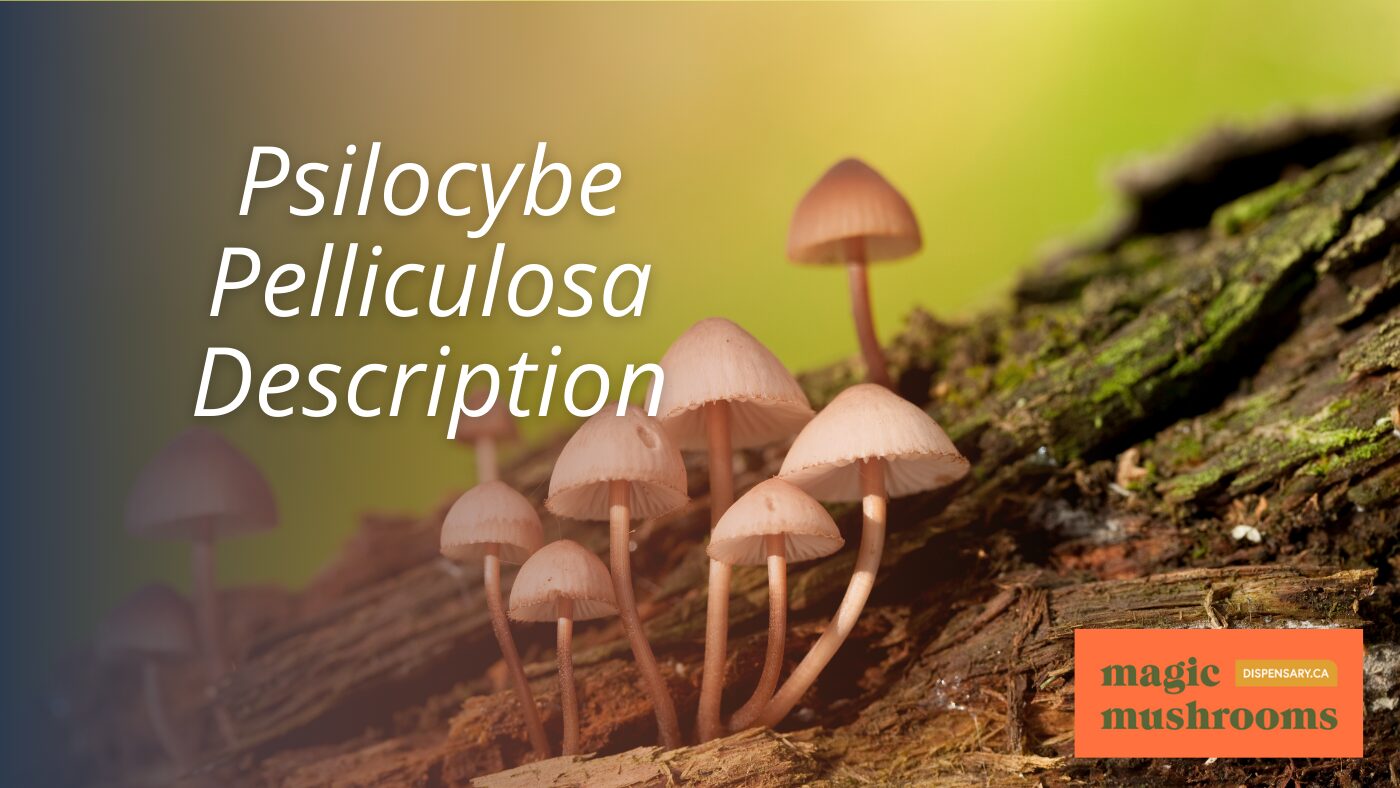
The Psilocybe pelliculosa, colloquially known as the Conifer Psilocybe, is a small, brown-capped mushroom notable for its slimy or sticky cap surface and its psychoactive properties. This species is prevalent in the coniferous forests of the Pacific Northwest region of North America, contributing to the region’s rich biodiversity and offering an intriguing subject for scientific research and exploration.
Characterized by a cap size usually ranging between 1-3 cm in diameter, the Psilocybe pelliculosa exhibits a conic to convex shape in its youth, which gradually flattens as the mushroom matures. The distinct viscid nature of the cap, coupled with the slender stem, makes it distinguishable among other species. Additionally, a striking feature that aids in the identification of this species is the blue bruising reaction it displays when handled, a result of the oxidation of psilocin, one of the psychoactive compounds present.
The psychoactive properties of Psilocybe pelliculosa are primarily due to the presence of psilocybin and psilocin. These compounds have been the subject of significant scientific interest due to their potential therapeutic applications in the treatment of various mental health disorders. Researchers are continuously exploring the potential benefits and risks associated with these compounds, in an aim to demystify their effects and harness their potential for the advancement of mental health treatments.
In essence, the Psilocybe pelliculosa stands as a symbol of the profound mystery and potential of nature’s creations, offering us an opportunity to deepen our understanding of the world around us and, possibly, within us.
The Distinct Psilocybe Stuntzii
Among the myriad of psilocybin-containing mushroom species native to the Pacific Northwest, the Psilocybe stuntzii, with its distinctive appearance and psychoactive properties, commands particular attention. Known for its conic to convex cap and a partial veil leaving a ring on the stem, this unique species is an embodiment of nature’s mysterious creativity and offers a gateway to an altered state of consciousness, sought by those with a desire for liberation.
Predominantly found in grassy areas, lawns, and wood chips, Psilocybe stuntzii is a common sight in urban environments, often appearing in clusters. This wide distribution makes it accessible for foragers and researchers alike, further adding to its significance.
One striking characteristic of Psilocybe stuntzii is its ability to bruise blue when handled or damaged, a clear indicator of the presence of psilocybin, the psychoactive compound responsible for its mind-altering effects. This response serves as nature’s own stamp of authenticity, guiding seekers towards this particular species amidst the vast fungal kingdom.
The potential therapeutic applications of psilocybin, particularly in the area of mental health, have sparked renewed interest in species such as Psilocybe stuntzii. As our understanding deepens, so does our appreciation for these natural marvels and the profound experiences they can facilitate.
Gymnopilus Spectabilis Identification
Shifting our attention to Gymnopilus spectabilis, also known as the Big Laughing Gym, we note this common North American psychedelic mushroom species is distinguishable by its unique physical characteristics and habitat preferences. This species is notable for its large, attractive fruit bodies that are characterized by their orange to rusty brown caps and yellow-orange gills.
One of the striking features of Gymnopilus spectabilis is its partial veil, which often leaves a ring on the stem. This feature, along with the mushroom’s robust stature and rusty brown spore print, adds to its distinctive appearance. It’s essential to keep in mind that the color of the cap can vary, depending on factors like age and weather conditions, and can sometimes cause confusion with other species. Therefore, careful observation is vital in its identification.
The Big Laughing Gym is renowned for its psychoactive properties, attributed to the presence of compounds such as psilocybin and psilocin. These naturally occurring psychedelic substances have been the focus of numerous studies, exploring their potential therapeutic applications.
The preferred habitat of Gymnopilus spectabilis is on wood, especially decaying conifer logs. This gives foragers a specific environment to target when seeking out the species. However, positive identification is crucial to guarantee safety.
Psilocybe Caerulescens Features
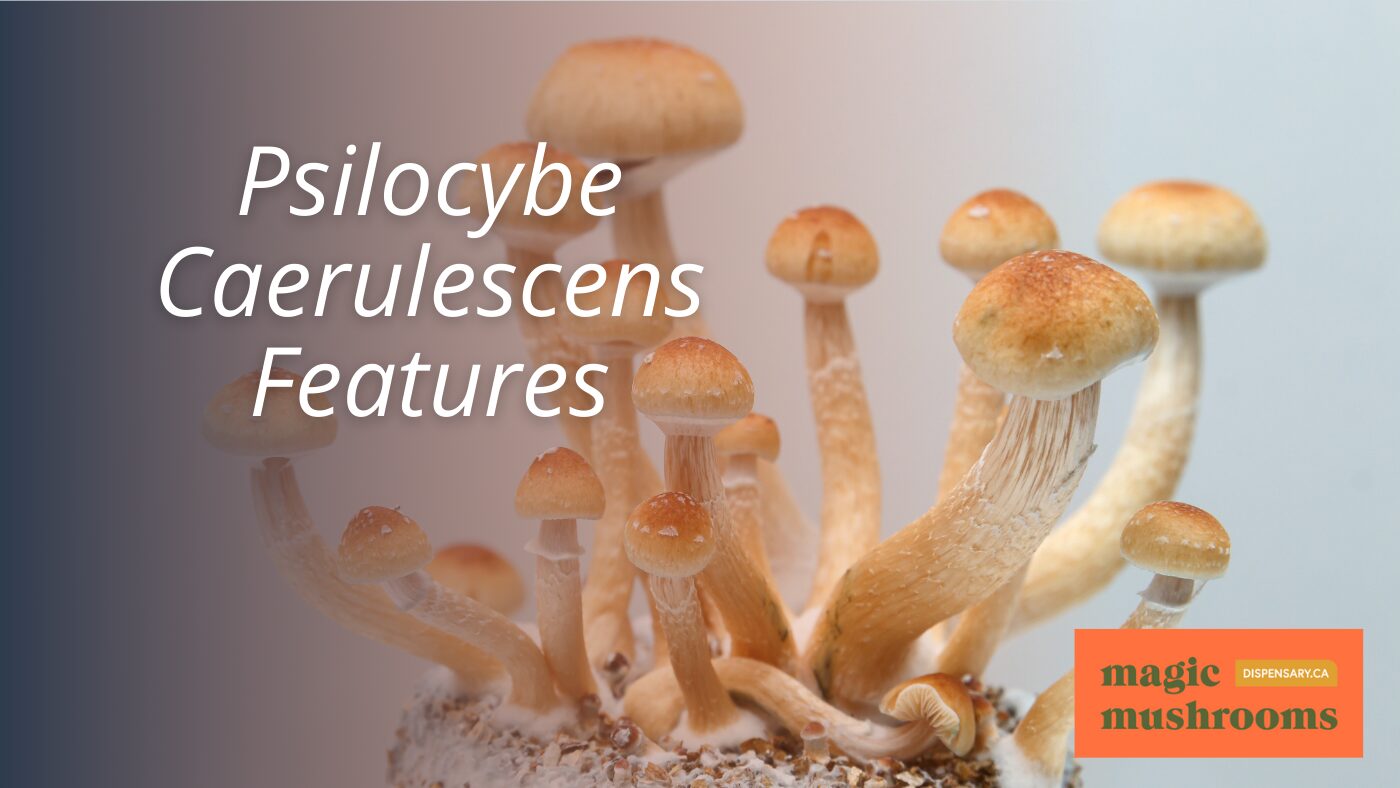
Rare yet highly potent, Psilocybe caerulescens stands out as a distinct species of magic mushroom, renowned for its strong psychedelic effects. This mushroom species is characterized by its high levels of psilocybin and psilocin, the active compounds responsible for its powerful hallucinogenic properties. Its rarity, combined with its potency, makes it an intriguing subject for those seeking the emancipatory experiences often associated with psychedelic exploration.
Psilocybe caerulescens is native to Mexico and Central America, where it has long been revered and utilized in spiritual ceremonies. This cultural significance underscores the deep, ancestral connections that many indigenous communities have with the psychedelic flora of their land. The traditional use of Psilocybe caerulescens in these regions provides a rich tapestry of ethnobotanical history, further enriching our understanding of the role of psychedelics in human culture and spirituality.
One notable feature of Psilocybe caerulescens is its blue bruising reaction, a clear indicator of the presence of psilocybin. This characteristic blue hue, which appears when the mushroom is bruised or cut, serves as a visual guide for those seeking to identify this species.
Though research on Psilocybe caerulescens is presently limited, its unique characteristics make it a species of interest for both psychedelic enthusiasts and researchers. As we continue to reveal, essential, unquestionably the potential therapeutic benefits of psilocybin and other psychedelic compounds, species like Psilocybe caerulescens will no doubt play a significant role in expanding our collective knowledge and offering new pathways to psychological liberation.
Panaeolus Sphinctrinus Characteristics
Shifting our focus to another intriguing psychedelic species, let’s delve into the features of Panaeolus sphinctrinus, a mushroom renowned for its distinctive appearance and psychoactive properties. With a wide distribution across North America and Europe, this species is a common sight in pastures and grassy areas. Its presence in such ordinary locales is a testament to nature’s knack for concealing extraordinary wonders in plain sight, a reminder that liberation is often found in unexpected places.
Panaeolus sphinctrinus is characterized by small, dark brown caps that are convex in shape, providing a unique silhouette against the backdrop of the green grass where it typically grows. This cap coloration can vary, however, depending on factors such as age and environmental conditions, adding to the species’ allure and mystique.
The gills of Panaeolus sphinctrinus are dark and closely spaced, contrasting starkly with its slender, delicate stem. This striking contrast is one of the mushroom’s most distinctive characteristics, making it easily identifiable to those in the know.
But it’s not just the physical characteristics that make the Panaeolus sphinctrinus remarkable. This species is also known for its psychoactive properties, thanks to the presence of hallucinogenic compounds psilocybin and psilocin. These compounds have been linked to transformative experiences and are currently the subject of numerous scientific studies investigating their potential therapeutic applications.
Recognizing Psilocybe Hoogshagenii
Exploring the world of the ‘Mexican magic mushroom,’ we encounter Psilocybe hoogshagenii, a potent psychedelic species native to Mexico known for its distinct physical characteristics and hallucinogenic effects. This species, like its kin, contains the psychoactive compounds psilocybin and psilocin, responsible for the intense visual and auditory hallucinations experienced by users.
Psilocybe hoogshagenii is essential in its morphology. The caps of this species are typically conic to convex in shape, presenting a distinct coloration that ranges from light to dark brown. It’s vital to familiarize oneself with these specific characteristics to avoid accidental ingestion of other non-psychoactive mushroom species that may resemble Psilocybe hoogshagenii.
The hallucinogenic properties of Psilocybe hoogshagenii have been utilized for centuries in traditional spiritual practices, believed to facilitate a transcendental state of consciousness. In contemporary times, these properties have been the subject of scientific and medical research, exploring the potential therapeutic applications of psilocybin and psilocin.
As with the consumption of any psychedelic substance, the experience with Psilocybe hoogshagenii can vary widely between individuals, influenced by factors such as dose, set, and setting. Users often describe a shift in perception, the amplification of emotions, and a heightened sense of connection to the world around them. However, it is important to approach this potent species with respect and caution due to the profound and unpredictable effects it can induce. Understanding the physical characteristics and potential impact of Psilocybe hoogshagenii is an essential step towards safely exploring the liberating world of psychedelic mushrooms.
Psilocybe Zapotecorum Description
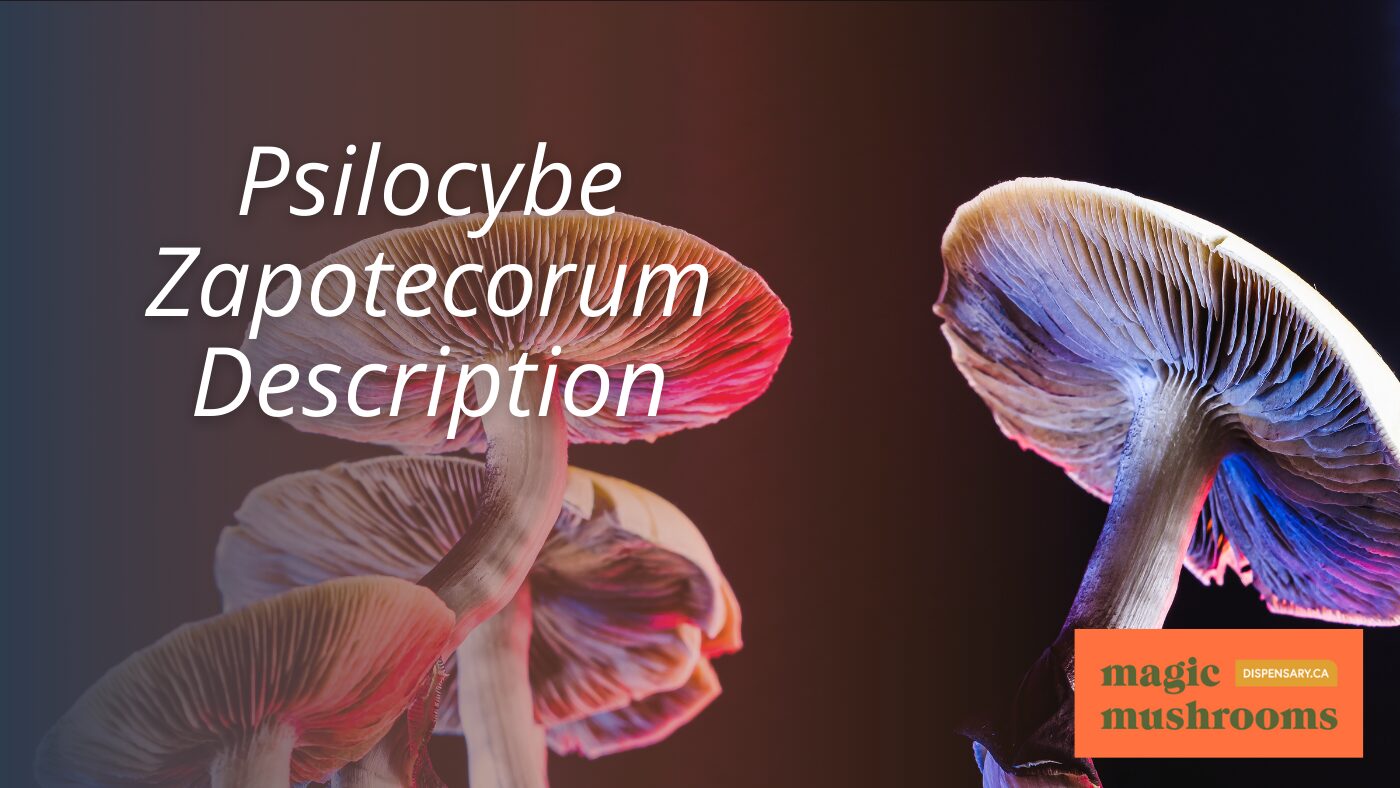
Exploring the diverse world of psychedelic mushrooms, we encounter Psilocybe Zapotecorum, a unique species native to Mexico, known for its psychoactive compounds and distinctive physical characteristics. Named after the region where it was first discovered, the Zapotec region of Mexico, this mushroom is a spectacle of natural evolution and chemical complexity.
Psilocybe Zapotecorum is characterized by its small to medium-sized fruiting bodies. Its cap, usually convex to broadly convex and sometimes umbonate, exhibits a brownish color that fades with age. The stem, slender and long, is also brown and becomes bluish at the base. The gills are cream to brown in color, and like many psilocybe species, it bruises blue when damaged, indicating the presence of psilocybin, a psychoactive compound found in magic mushrooms.
When consumed, Psilocybe Zapotecorum induces effects such as hallucinations, altered perception, and changes in mood and cognition. These effects are due to the psilocybin and psilocin present in the mushroom. Psilocybin is metabolized into psilocin in the body, which then interacts with serotonin receptors in the brain to produce its psychoactive effects.
Despite its potential for recreational use, it’s the therapeutic possibilities of Psilocybe Zapotecorum that are most intriguing. Ongoing research is focused on understanding its chemical composition, effects, and potential therapeutic applications. There is hope that these humble fungi, once marginalized and misunderstood, might hold the key to new treatments for a range of mental health conditions, offering liberation from the confines of traditional psychiatry.
The Unique Psilocybe Allenii
In the world of psychedelic fungi, Psilocybe allenii stands out as a common species found mainly in urban areas of the Pacific Northwest. This robust mushroom, recognized by its broad, convex to flat cap and cinnamon-brown to dark-brown coloration, thrives in environments layered with wood chips and decomposed organic matter. The affinity for such substrates leads it to colonize public parks, gardens, and other urban green spaces, making it readily accessible for foraging.
Psilocybe allenii carries within its fibrous structure the compound psilocybin, a naturally occurring psychedelic substance. This compound, when ingested, is converted into psilocin, which then interacts with serotonin receptors in the brain. This interaction can induce altered states of consciousness, characterized by variations in mood, perception, and cognition, providing the potential for psychological exploration and self-discovery.
One of the fascinating characteristics of this species is its bruising reaction. When damaged, Psilocybe allenii turns a purplish-blue, a trait common to many psilocybin-containing mushrooms. This reaction is believed to be a defensive mechanism against predation, but also serves as an essential identification feature for foragers and researchers.
In the quest for liberation, understanding the unique features and capabilities of Psilocybe allenii can provide a pathway to access its potential benefits. As research continues and appreciation grows for this humble fungi, one can only imagine the untapped possibilities that lie within its spore-laden gills. As we tread lightly in the world of these ethereal organisms, remember to approach with respect, knowledge, and an openness to the profound experiences they can offer.
Psilocybe Subaeruginascens Features
What unique features characterize Psilocybe subaeruginascens, another species of psychedelic mushroom in the Psilocybe genus? This particular mushroom is renowned for its psychoactive properties, attributed to the presence of compounds psilocybin and psilocin that trigger hallucinogenic effects. Its distinguishing properties open the door for a deeper understanding of psychedelic species and their potential therapeutic benefits.
One key feature of Psilocybe subaeruginascens is its bluing reaction when bruised. This occurs due to the oxidation of psilocin, a phenomenon common among psilocybin-containing mushrooms. This characteristic is not merely an aesthetic feature, but a vital identification marker for foragers and researchers.
Geographically, Psilocybe subaeruginascens displays a widespread distribution. It is commonly found across various global regions, favoring grassy areas or woodlands. This mushroom’s adaptable nature suggests a resilience that enables it to thrive in diverse environments, a trait that amplifies its research potential.
As we venture into the field of psychedelic research, the Psilocybe subaeruginascens species holds promise. Its chemical composition is an ongoing subject of study, primarily focusing on its potential therapeutic applications. The psilocybin and psilocin present in this mushroom are known for their hallucinogenic effects, but they may also contribute to potential mental health treatments. This prospect of beneficial application fuels the curiosity and interest surrounding Psilocybe subaeruginascens.
To summarize, the unique features of Psilocybe subaeruginascens, including its psychoactive compounds, bluing reaction, geographical distribution, and potential therapeutic benefits, make it a fascinating subject for further research and understanding in the field of psychedelic species.
Recognizing Psilocybe Serbica
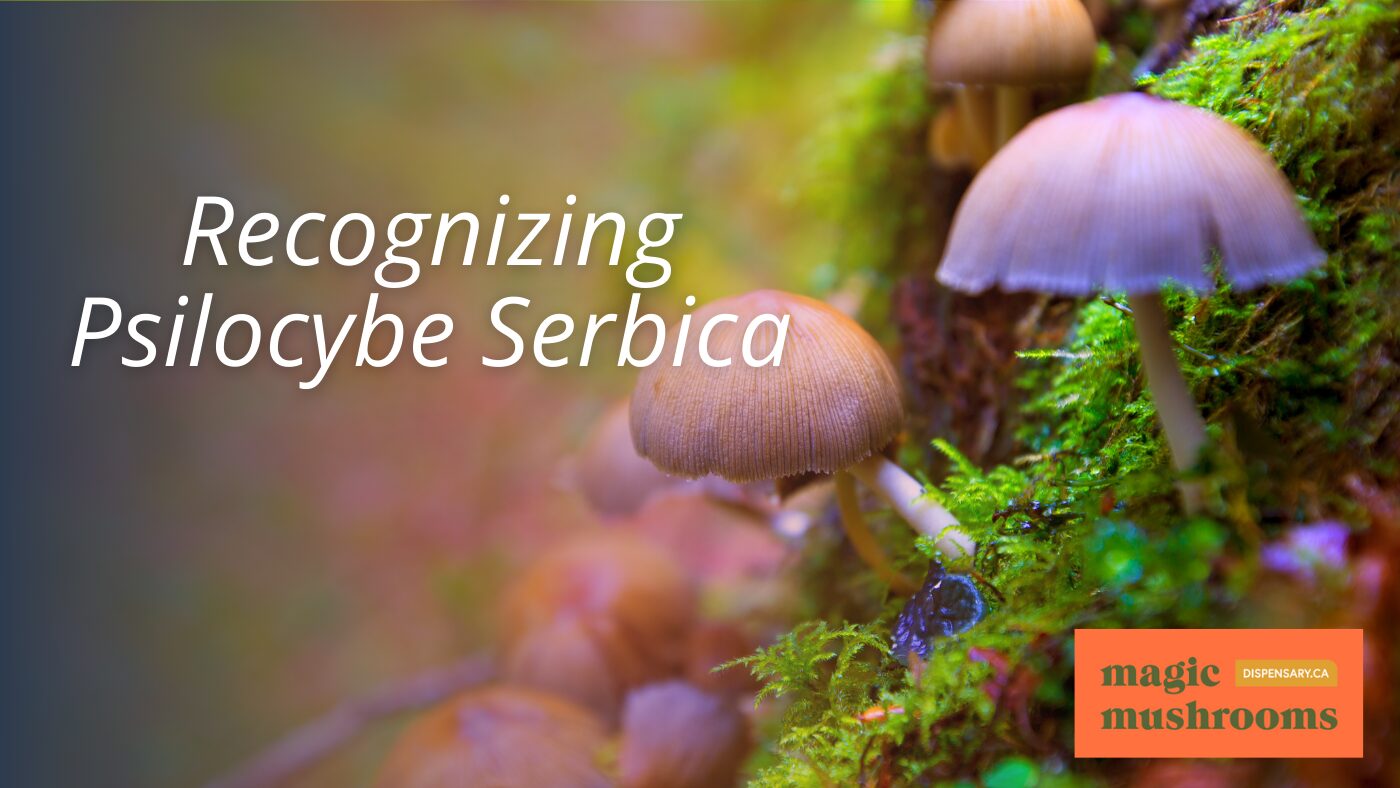
Shifting our focus to another significant species in the Psilocybe genus, we turn to Psilocybe serbica, a magic mushroom known for its psychoactive properties. This indigenous European mushroom, primarily found in Serbia and other surrounding areas, belongs to the Psilocybe genus, a group of fungi renowned for their psychoactive compounds, namely psilocin and psilocybin.
Psilocybe serbica exhibits a wide range of variations, particularly in its production of tryptamine alkaloids. This diversity can affect the potency and overall psychoactive effects of the mushroom, making it essential for users to have a thorough understanding of the species. Knowledge of the chemical composition of Psilocybe serbica can lead to safer consumption practices and potentially enhance the user’s experience.
Identifying Psilocybe serbica can be a complex task due to its close resemblance to other species in the Psilocybe genus. However, through careful observation and phylogenetic analysis, one can distinguish this species from its relatives. Psilocybe serbica commonly exhibits a chestnut to dark brown cap, which becomes lighter with age. Its gills are initially a pale color, turning purple-brown as the mushroom matures.
In our pursuit of liberation and understanding, recognizing the nuanced characteristics of each Psilocybe species is imperative. With Psilocybe serbica, the key lies in appreciating its unique chemical composition and the significant psychoactive properties it possesses. As we explore further into the world of psychedelic mushrooms, we continue to expand the boundaries of our knowledge, seeking enlightenment through nature’s hidden gems.
Psilocybe Mexicana Identification
Have you ever encountered Psilocybe Mexicana, renowned for its distinctive reddish-brown, slimy appearance and potent hallucinogenic effects? This species, commonly referred to as the Mexican mushroom, is a fascinating study of nature’s ingenuity in creating potent substances that can alter human consciousness.
Psilocybe Mexicana is a typical figure in Mexico and Central America’s humid, subtropical regions. Its presence has been woven into the region’s history, traditions, and spiritual practices, given its psychoactive properties. The small to medium-sized mushrooms of this species are characterized by conical to bell-shaped caps, a defining feature for identification. When moist, they exhibit a sticky or slimy texture, contributing to their unique tactile identity.
The reddish-brown coloration of Psilocybe Mexicana is another key marker for those seeking to identify this species. This color, combined with its distinctive cap shape and slimy texture, sets it apart from many other mushrooms. However, it’s worth noting that color can vary depending on environmental factors and maturity, emphasizing the importance of considering multiple identification markers.
Ingesting Psilocybe Mexicana may induce hallucinogenic effects, similar to other psilocybin-containing mushrooms, due to its psilocybin content. This substance is the primary component responsible for the mind-altering experiences reported by those who consume psychedelic mushrooms.
For those seeking an understanding of nature’s complex chemistry and the liberation that knowledge can bring, correctly identifying Psilocybe Mexicana is an essential step. With careful observation and a keen understanding of its distinctive features, this intriguing species can be safely and accurately identified.
The Distinct Gymnopilus Luteofolius
Exploring the diverse world of psychedelic mushrooms, we encounter Gymnopilus luteofolius, a species known for its distinctive yellow-orange cap and hallucinogenic properties. Characterized by a slimy texture, this particular mushroom is visually striking and easily distinguishable from other species.
Gymnopilus luteofolius contains psilocybin and psilocin, active compounds responsible for the mushroom’s hallucinogenic effects. These compounds can induce altered perceptions, visual distortions, and changes in mood and consciousness, offering an avenue for investigation and introspection for those seeking liberation through psychedelic experiences.
Habitat-wise, Gymnopilus luteofolius is prevalent in temperate climates, often found growing on decaying wood in regions spanning North America and Europe. Its widespread presence further underscores its importance in the vast landscape of psychedelic fungi.
One practical approach to identifying Gymnopilus luteofolius involves examining its spore print, which exhibits a rusty orange-brown color. This is a fundamental technique in mycology, the study of fungi, and can be instrumental in distinguishing this species from other similar-looking mushrooms.
Ingesting Gymnopilus luteofolius can lead to profound psychedelic experiences, but caution is necessary. While the allure of such experiences can be compelling, safety and correct identification should always be of utmost importance. The world of psychedelic mushrooms is a fascinating domain of natural wonder, and Gymnopilus luteofolius is a prominent figure within it, offering unique experiences and insights for those bold enough to explore its mysteries.
Psilocybe Tampanensis Description
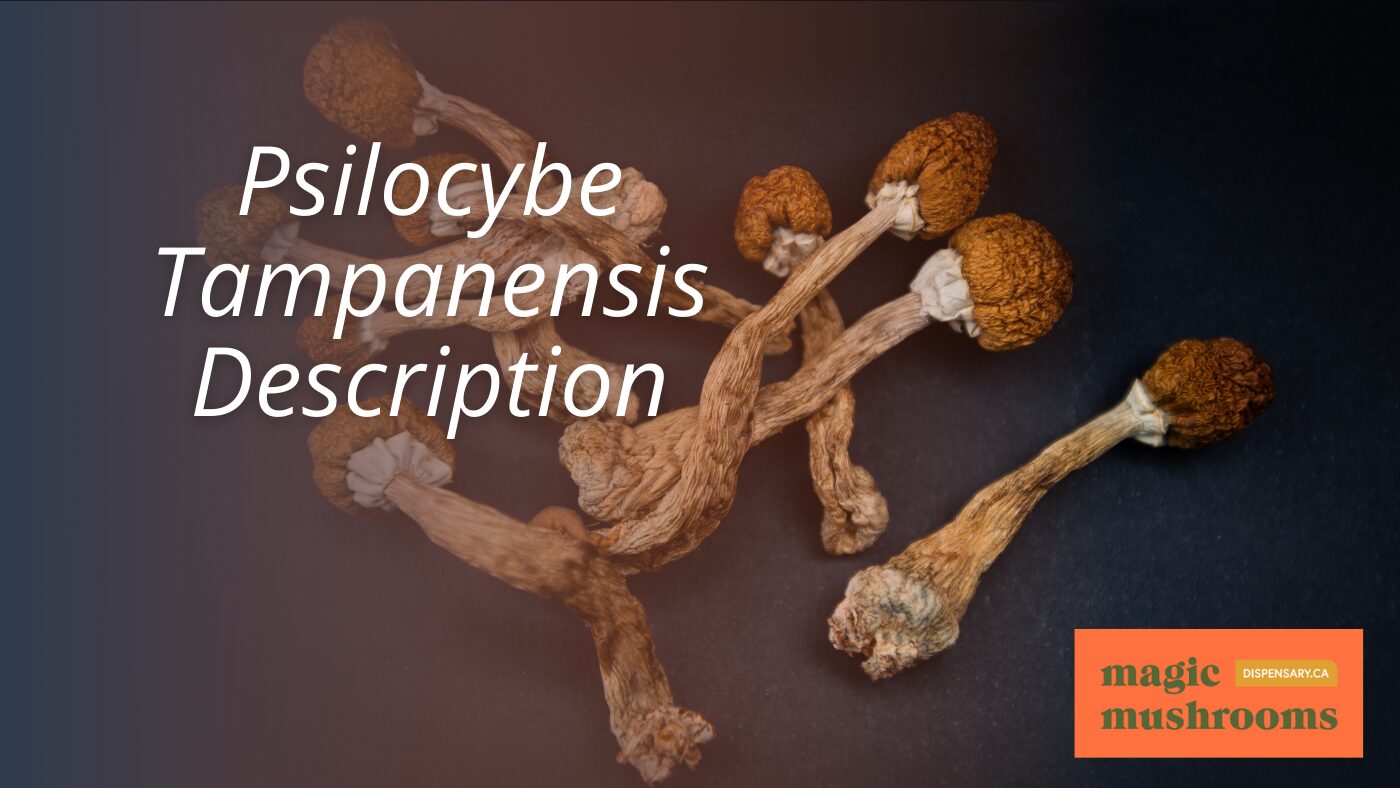
Delving into the intriguing domain of psychedelic mushrooms, we encounter the rare and unique Psilocybe tampanensis, often referred to as the ‘Philosopher’s Stone’. This species, discovered in Tampa, Florida, in the early 1970s, is a distinctive member of the Psilocybe genus, renowned for its potent psychoactive properties.
One of the key features that sets Psilocybe tampanensis apart from other psychedelic mushrooms is its unique truffle-like sclerotia. These hardened, underground masses are rich in the psychoactive compounds psilocybin and psilocin, which are known for their transformative effects on human consciousness. Unlike the fleeting fruiting bodies of other mushrooms, these sclerotia provide a long-lasting and stable source of psychedelic substances, contributing to the species’ rarity and prized status among foragers and researchers alike.
While Psilocybe tampanensis produces a psychoactive experience, it is considered milder compared to other psilocybin mushrooms. This characteristic, combined with its distinctive physical features, makes it a highly sought-after species among psychedelic enthusiasts. This species offers a unique pathway to cognitive liberation, providing a gentle introduction to the world of psychedelic exploration for novices, and a nuanced experience for seasoned practitioners.
Nevertheless, as with all psychedelic substances, caution and respect are advised. Despite the potential for profound personal insight and spiritual growth, these substances should be used responsibly, under the guidance of experienced practitioners. As we continue to explore the fascinating world of mushroom psychedelics, the Psilocybe tampanensis, with its unique sclerotia and milder effects, remains a thought-provoking subject of study.
The Unique Psilocybe Atlantis
Venturing further into the domain of psychedelic fungi, we encounter the unique Psilocybe atlantis, a rare species known for its distinctive conical cap, slender stem, and potent psychoactive properties. This fascinating species, lesser-known in the world of psychedelic mushrooms, demonstrates an intriguing blend of mystique, history, and potential therapeutic value.
Believed to have originated from the Azores islands in Portugal, Psilocybe atlantis exhibits a strong geographical identity, which makes it an interesting focus for researchers and enthusiasts alike. This species is an integral part of the psilocybin-rich fungi family, a group of mushrooms that is gaining significant global attention for its potential applications in mental health treatments.
The unique appearance of Psilocybe atlantis, characterized by its conical cap and sleek stem, is a distinct marker that aids in its identification. However, its true defining characteristic lies in its potent psychoactive properties. Rich in psilocybin and psilocin, the species is known to induce altered perception and hallucinations, effects similar to other members of the psilocybin-containing family.
As we continue to explore our understanding of these fungi, it is important to remember that each species, including the rare Psilocybe atlantis, has a unique profile. The potential therapeutic implications of psilocybin and its effects on the human mind are areas of ongoing exploration. The journey into the world of psychedelic mushrooms is a thrilling ride, filled with mystery, potential, and a deeper understanding of nature’s power. As we investigate further, each species provides another piece to the puzzle, widening our horizon of knowledge and understanding.
Psilocybe Urospora Identification
Exploring the diversity of psychedelic mushrooms, we encounter Psilocybe urospora, a distinct North American species known for its unique physical characteristics and potent psychoactive compounds. This mushroom species is notable for its distinctive conic to bell-shaped cap and a slimy texture when moist, distinguishing it from other members of the Psilocybe genus.
Psilocybe urospora’s cap can range in color from light brown to yellowish-brown, often with a darker center that adds to its unique visual appeal. However, the real allure of this mushroom lies in the psychoactive compounds it contains. Like its more famous relatives, Psilocybe cubensis and Psilocybe semilanceata, Psilocybe urospora contains the potent compounds psilocybin and psilocin. These substances are known to induce altered states of consciousness, which some users describe as spiritually enlightening or therapeutically beneficial.
Equally important in the study of Psilocybe urospora is understanding its preferred habitat. This species is typically found in grassy areas, woodlands, and meadows across North America. Its presence in these ecosystems indicates a strong adaptability and resilience, traits that are essential for the survival of any species.
The Distinct Psilocybe Bohemica
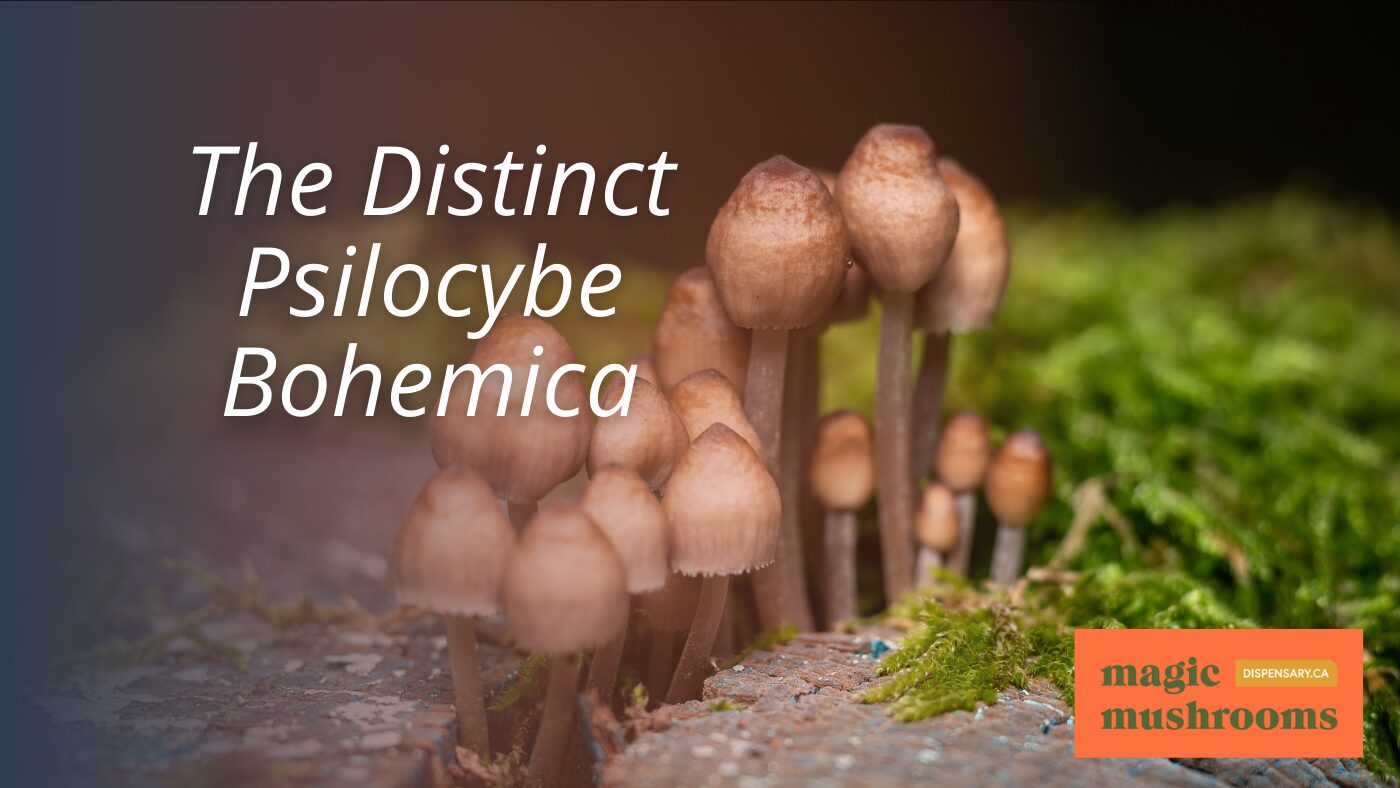
In the diverse world of psychedelic mushrooms, the distinct Psilocybe bohemica stands out, renowned for its psychoactive properties and prevalence in European regions, particularly the Czech Republic. This species represents a compelling facet of the mycological landscape, offering a unique perspective on the symbiotic relationship between flora and fauna in the region.
Psilocybe bohemica is recognized for its distinctive characteristics that separate it from other magic mushroom species. The mushroom’s notable features include a convex to broadly convex cap, its deep chestnut brown color, and a typically dry surface. This unique appearance, coupled with its habitat preference for deciduous woods, specifically in areas littered with fallen leaves and twigs, makes it easily distinguishable for those seeking to identify it.
The bohemica species contains psilocybin and psilocin, compounds responsible for the mushroom’s psychoactive properties. These hallucinogenic compounds provide a unique sensory experience, often described as a journey of introspection and heightened awareness, which has attracted an audience seeking personal liberation and self-exploration.
Scientific interest in Psilocybe bohemica extends beyond its chemical composition and psychoactive effects. Researchers are also examining its potential therapeutic uses, particularly for mental health treatments. Preliminary studies suggest that psilocybin, the active compound in Psilocybe bohemica, could be effective in treating conditions such as depression and anxiety.
Conclusion
In conclusion, investigating mushroom psychedelic species such as Psilocybe cyanescens, Psilocybe allenii, and Psilocybe ovoideocystidiata provides a distinct insight into the realm of psychoactive fungi. The complex defense mechanisms, global distribution, and potential uses in mental health treatments of these species open up new paths for scientific research and therapeutic applications. Indeed, the mysteries and possibilities that these fascinating mushroom psychedelic species may hold are yet to be fully discovered in the future.
Buying Microdosing Mushrooms Online in Canada
Are you an avid microdoser or looking to venture into the art of microdosing? Working with a reliable, trustworthy shrooms dispensary is paramount in becoming a better version of yourself. Magic Mushroom Dispensary prides itself on its comprehensive collection of top-notch microdosing products, psilocybin books, excellent customer service, and fast, discreet shipping. Visit our online shop today and enjoy low prices and free shipping for orders above $99.
Originally posted on June 30, 2024 @ 9:57 am
